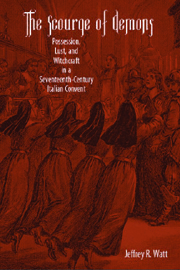Book contents
- Frontmatter
- Contents
- List of Illustrations
- Acknowledgments
- Introduction: Nuns, Witchcraft, and the Inquisition
- Chapter 1 Female Religious, Claustration, and Santa Chiara of Carpi
- Chapter 2 The Outbreak and Maleficia
- Chapter 3 The Confessor and Love Magic
- Chapter 4 The Exorcists and the Demons
- Chapter 5 Sisters Dealta and Ippolita under Attack
- Chapter 6 Bellacappa's Defense
- Chapter 7 The Waning of the Possessions
- Conclusion
- Appendix A
- Appendix B
- List of Abbreviations
- Notes
- Selected Bibliography
- Index
Chapter 4 - The Exorcists and the Demons
Published online by Cambridge University Press: 12 September 2012
- Frontmatter
- Contents
- List of Illustrations
- Acknowledgments
- Introduction: Nuns, Witchcraft, and the Inquisition
- Chapter 1 Female Religious, Claustration, and Santa Chiara of Carpi
- Chapter 2 The Outbreak and Maleficia
- Chapter 3 The Confessor and Love Magic
- Chapter 4 The Exorcists and the Demons
- Chapter 5 Sisters Dealta and Ippolita under Attack
- Chapter 6 Bellacappa's Defense
- Chapter 7 The Waning of the Possessions
- Conclusion
- Appendix A
- Appendix B
- List of Abbreviations
- Notes
- Selected Bibliography
- Index
Summary
The women who were suffering at Santa Chiara received a variety of treatments for their ailments. When they first took ill, a physician and surgeon examined them and prescribed some cures. Once those proved ineffective, emphasis shifted to spiritual remedies. As the malaise of the ten nuns continued, in 1638 the entire community of Santa Chiara started holding special offices daily to beseech God to assuage the ills that plagued them, and the bewitched nuns went to Mass and received the Eucharist every day. A half century earlier, Girolamo Menghi had listed a number of spiritual weapons to protect oneself against witchcraft: fasting, praying, making the sign of the cross, going to confession, attending Mass, invoking the saints, reciting litanies, sprinkling oneself with holy water, and putting exorcized salt in one's mouth. One could also carry with oneself either a candle that was blessed on Candlemas (2 February), oil or a palm that was blessed on Palm Sunday, or a card on which were written sacred words, such as “Iesus Nazarenus Rex Iudaeorum,” the names of the evangelists or the Virgin Mary, or simply “In the beginning.” In other words, the most potent weapons against demon possession and witchcraft were the sacraments of penance and the Eucharist and a range of sacramentals, be they prayers, rituals, or objects. Menghi and other authorities on exorcism and witchcraft agreed, however, that it was totally unacceptable to fight witchcraft with witchcraft.
- Type
- Chapter
- Information
- The Scourge of DemonsPossession, Lust, and Witchcraft in a Seventeenth-Century Italian Convent, pp. 104 - 140Publisher: Boydell & BrewerPrint publication year: 2009



